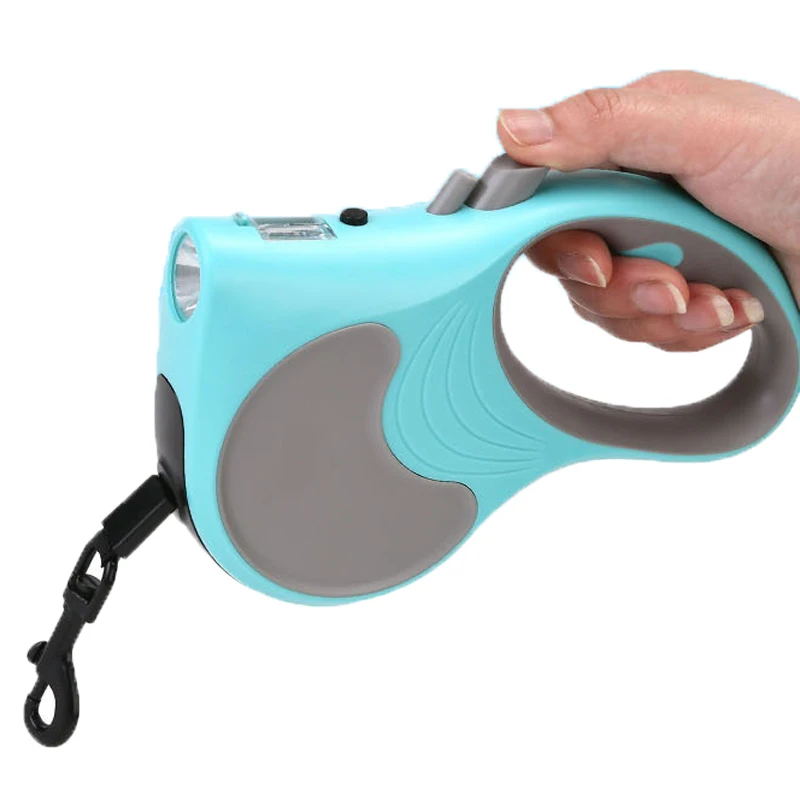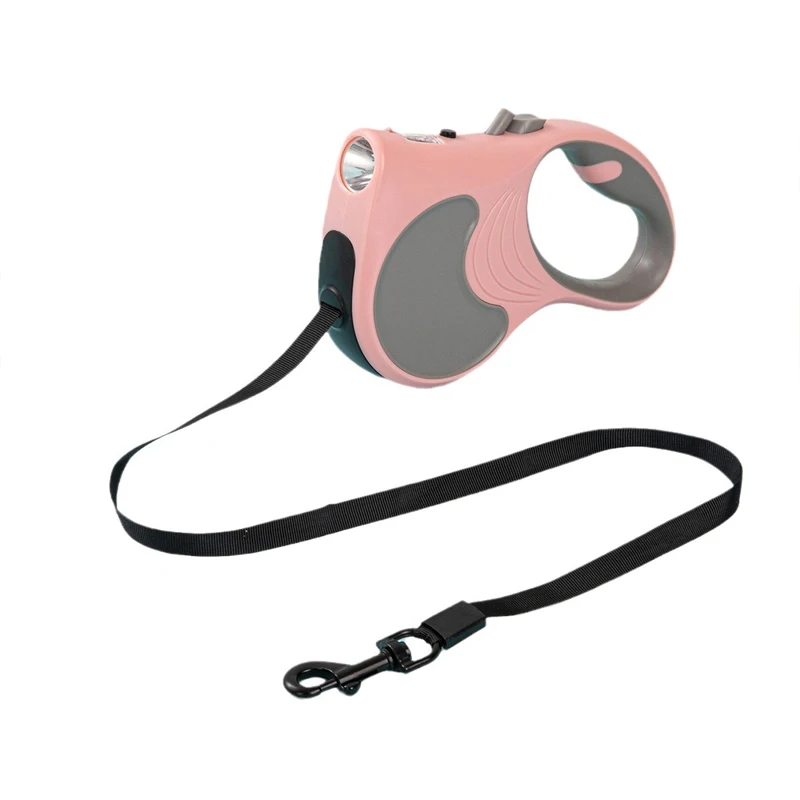Introduction to Retractable Leashes
Retractable leashes, often known as Flexi leads, let dogs explore with more range. These devices feature a lengthy cord housed in a spring-loaded handle. Users can control how much cord is released or retracted with a button. This type of leash grants dogs more freedom compared to standard leashes. They can sniff around and move more freely during walks, seeming less confined.
However, while retractable leashes offer more freedom, they are controversial among dog trainers and owners for several reasons. There are inherent risks and complications that might not be immediately apparent. For example, the long cord can allow dogs to move far ahead of their owners. This distance can be hazardous in situations like crossing streets or encountering aggressive animals.
Moreover, the mechanics of retractable leashes, including the handle and spring-loaded recoiling system, can sometimes fail. This malfunction can lead to dangerous situations if the leash suddenly retracts or fails to retract when needed. Understanding these complexities is essential for anyone considering a retractable leash for their pet.

Potential Injuries from Retractable Leashes
Retractable leashes can pose a risk of injury to both dogs and their owners. Serious injuries have been reported due to the misuse of these leashes. Below are some potential injuries that can occur from retractable leashes:
- Cuts and Burns: The thin cord of a retractable leash can cause severe cuts or burns if it wraps around someone’s skin. This can happen when trying to grab the cord or if the dog suddenly runs, causing the cord to pull through hands or legs.
- Amputations: There are extreme cases where people have suffered finger amputations. This usually occurs when the leash cord wraps tightly around a finger and the dog suddenly pulls away.
- Broken Bones: People can trip over the long cords or be pulled off their feet if the dog runs abruptly to the end of the leash line.
- Neck Injuries in Dogs: When dogs dash off and reach the end of the leash quickly, they can suffer from neck wounds or a lacerated trachea due to the sudden jerk.
- Road Accidents: Dogs can unexpectedly run into the street, which can lead to accidents, as they have a wider radius to move away from their owner.
To prevent these injuries, dog owners must be highly attentive and cautious when using retractable leashes. Ensuring the leash is properly locked at a safe length and that the surroundings are free from hazards is important.
The Illusion of Freedom and Control
Retractable leashes often give the illusion of freedom and control, but this can be misleading. At first glance, these leashes allow dogs more freedom to explore their surroundings. The long cord lets dogs roam further away from their owners compared to standard leashes. This seems like a benefit, as it lets dogs investigate smells and environments at their own pace.
However, this perceived freedom comes with significant risks. The distance between the dog and the owner can become dangerously large. This makes it hard for owners to control their pets in unexpected situations. If a dog encounters a threat or strays too far, the owner might not be able to react quickly enough. This delay can lead to accidents or aggressive interactions with other animals or people.
Moreover, the control aspect of retractable leashes is often overestimated. Although they are equipped with buttons to stop and lock the leash length, these mechanisms can fail. If a locking mechanism malfunctions, dogs can unexpectedly run off, leading to potential mishaps or even tragedies.
Owners might think they have full control with the ability to recall their dog using the leash’s button. Yet, if the dog has moved too far or the lock fails, this control is merely theoretical. The situation can escalate, especially in busy or dangerous environments.
In conclusion, while retractable leashes offer an illusion of control and freedom, they often do not provide adequate safety for dogs or their owners in many situations.
The Impact on Training and Behavior
Retractable leashes can affect dog training and behavior in various ways. Here are some key impacts:
- Encourages Pulling: These leashes often teach dogs to pull. The more they pull, the more leash they get. This can make proper leash training very difficult.
- Weakens Recall: When dogs learn they can wander far, their recall may weaken. This is because they feel less need to stay close to their owner.
- Inconsistent Commands: Mixed signals from the leash’s ‘stop’ and ‘release’ buttons can confuse dogs. They may struggle to understand when pulling is allowed and when it is not.
- Reduces Attention: Dogs on retractable leashes can become less attentive to their owners. They might ignore commands because they are too far to hear or are distracted.
- False Sense of Security: Owners may feel they have control with the lock button. But if it fails, control is lost. This can lead to dogs not learning boundaries.
It is clear that retractable leashes may offer short-term convenience but carry long-term drawbacks. They can undermine the hard work put into training a dog. Proper behavior on walks comes from consistent training with predictable equipment. For a dog to learn, they need clear and consistent guidance.

Safety Concerns in Public Spaces
Retractable leashes can create unexpected dangers in busy areas. Their long cords allow dogs to roam far from their owners. This distance can lead to encounters with traffic, strangers, or other animals. These interactions are not always predictable and can become hazardous quickly.
Here are safety concerns to consider:
- Traffic Risks: Dogs can easily venture into the street. Oncoming cars may not see them in time. Busy intersections are particularly dangerous.
- Entanglement Issues: The leash’s cord can trap people or pets. In crowded places, the risk of tangling increases.
- Loss of Control: If a dog is far away, sudden situations are harder to manage. Quick action is often needed to prevent harm.
- Fearful Dog Risks: Dogs that are scared by loud noises or quick movements may panic. If the leash handle drops, it can chase and frighten them. This could lead to a dog running into danger.
- Injuries to Others: The leash cord can cause injuries if contact occurs. Cuts, burns, or worse can happen during accidents with the cord.
Given these concerns, it is essential to use retractable leashes with care. Ensure the leash is locked at a short length in crowded places. Always stay aware of the surroundings to maintain safety.
Appropriate and Inappropriate Use Cases
Retractable leashes may not be all bad, but they have specific use cases. Let’s explore when they are appropriate and when they should be avoided.
- Inappropriate for Highly Trafficked Areas: Given their length, retractable leashes are not safe in busy streets or near traffic.
- Inappropriate for Untrained Dogs: They can encourage bad habits like pulling, making training harder.
- Inappropriate for Reactive Dogs: Dogs with aggression issues can become dangerous when on a long leash. They might confront other dogs or people, escalating to unsafe situations.
- Inappropriate in Crowded Spaces: The risk of injury from the cord is high in places with lots of people.
- Inappropriate for Fearful Dogs: Retractable leashes can scare a dog if the handle is dropped and it ‘chases’ them.
On the flip side, there are scenarios where retractable leashes could be used with caution.
- Appropriate for Open Spaces: They can offer controlled freedom in a large, empty field away from any dangers.
- Appropriate for Quick Potty Breaks: If you’re in a safe, enclosed space, a retractable leash can give your dog a little more room to move.
- Appropriate for Confident, Trained Dogs: If your dog is well-behaved and trained, the leash can provide a bit of free roaming during walks.
- Appropriate for Owners with Mobility Issues: As a long line alternative, retractable leashes might be better for those who have trouble handling normal leashes.
Retractable leashes are not inherently bad, but require careful consideration of the context they are used in. Follow these guidelines to use retractable leashes safely and effectively.

Safer Alternatives to Retractable Leashes
When considering the risks of retractable leashes, it’s important to explore safer alternatives. Here are some better options for you and your dog:
- Standard Fixed-Length Leashes: These offer more control and less risk of injury.
- Adjustable Leashes: They have different length settings without the dangers of a retractable cord.
- Double-Handled Leashes: Provide an extra loop closer to the dog for increased control in crowded areas.
- Hands-Free Leashes: Great for joggers, these wrap around your waist and keep your hands free.
- Leash Couplers: For walking multiple dogs with less tangling than retractable leashes.
- Long Lines: Good for training, they give dogs freedom but still offer control.
- Harnesses with Short Leads: These can prevent neck injuries and provide better handling.
For each type of leash, ensure they match your dog’s size and strength. Use lockable buckles and sturdy materials. Practice good leash manners, so walks are safe and enjoyable. By choosing the right tools and training your dog, both of you can have stress-free outdoor adventures.
Conclusion: Balancing Convenience and Safety
Retractable leashes may seem handy, but they come with real risks. They can give dogs freedom, but this can lead to accidents, injuries, or worse. They’re not always the best for control and can confuse training efforts. It’s crucial to weigh the convenience against the potential dangers.
For safe walking, consider where and how you use a retractable leash. Avoid busy streets, crowded areas, and use with untrained or reactive dogs. In open, quiet spaces, they can work well under close watch.
Always put safety first. Choose fixed-length or adjustable leashes for more control. Train your dog well, no matter the leash type. Use retractable leashes wisely, if at all.
Remember, the goal is a safe, enjoyable walk for both you and your dog. Choose tools and training that make this possible. Ensuring your dog’s safety is a responsibility not to be taken lightly.










